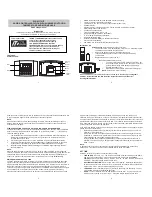
Operation
RFI-9256 Radio Modem User Manual
Page 21 of 109
Setting
Possible Values
Default
Baud
110, 300, 600, 1200, 2400, 4800, 9600, 19200, 38400, 57600, 115200 19200
Data bits 7, 8
8
Parity
None, Odd, Even
None
Stop bits 1, 2
1
Table 5: Serial port configuration
5.1.2 Control Lines and Flow Control
The main serial port has four control lines:
Request to Send (RTS)
Clear to Send (CTS)
Data Terminal Ready (DTR)
Data Carrier Detect (DCD)
The main serial port supports hardware flow control using the RTS and CTS control lines. When hardware
flow control is enabled:
The radio will only transmit data to the DTE when the RTS line is high.
The radio will raise the CTS line when the input buffer is less than the Rx buffer limit (default is
3072 Bytes), and drop the CTS line when its input buffer is greater than or equal to the Rx buffer
limit.
The flow control Rx buffer limit can be configured by the user.
In addition to hardware flow control, the CTS and DCD lines can be configured to behave in one of the
following ways:
ONLINE controls CTS/DCD:
The line is active when the front panel online LED is green or red,
and is off when the front panel online LED is off.
NEWTORK LINK controls CTS/DCD:
The line is active when the front panel network link LED is
green or red, and is inactive when the front panel online LED is off.
CARRIER DETECT controls CTS/DCD:
The line is active when the front panel carrier detect
LED is green or red, and is inactive when the front panel online LED is off.
Remote DTR controls CTS/DCD:
The line is active when a remote radio’s DTR input line is active
in point-to-point or Hayes dial-up mode.
Local DTR controls CTS/DCD:
The line is active when the local radio’s DTR input line is active.
Remote RTS controls CTS/DCD:
The line is active when a remote radio’s RTS input line is active
in point-to-point or Hayes dial-up mode.
Local RTS controls CTS/DCD:
The line is active when the local radio’s RTS input line is active.
CTS/DCD Always ON:
The line is always active.
Main -> Serial Port
















































